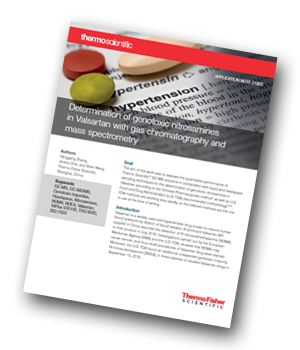This application note provides an evaluation of the quantitative performance of the Thermo Scientific™ TriPlus™ 500 Gas Chromatography Headspace Autosampler for determination of genotoxic nitrosamines in Valsartan according to the Chinese Pharmacopoeia method and US FDA recommended methodology.
 Introduction
Introduction
Valsartan is a widely used anti-hypertensive drug known to reduce human blood pressure by dilation of blood vessels. Huahai Pharmaceutical, a dominant Valsartan API supplier in China, reported the detection of N-nitrosodimethylamine (NDMA) in their product on July 2018. Investigations carried out by the European Medicines Agency (EMA) and the US-FDA, showed that NDMA may cause cancer, and thus recall procedures of Valsartan drug were started. Moreover, the US-FDA found an additional unexpected genetoxic impurity, N-nitrosodiethylamine (NDEA), in three batches of recalled Valsartan drugs in September 13, 2018.
1. Detection of nitrosamines in Valsartan by liquid injection GC-MS
This refers to the C-FDA recommended method for the detection of nitrosamine in Valsartan. Methanol was used for liquid-liquid extraction of the drug (Valsartan) sample. Following centrifugation, an aliquot of the supernatant was injected and tested for nitrosamines using single quadrupole GC-MS. Using this C-FDA method, only NDMA was detected in Valsartan, although both NDMA and NDEA were targeted.
2. Detection of nitrosamines In Valsartan by Headspace GC-MS
There are two headspace methods recommend by USFDA: “GC-MS Headspace Method for Detection
of NDMA in Valsartan Drug Substance”; Method 2: “Combined N- Nitrosodimethylamine (NDMA) and
N- Nitrosodiethylamine (NDEA) Impurity Assay By GC-MS-Headspace”. Method 1 uses dimethyl sulfoxide (DMSO) to dissolve the drug and then headspace GCMS analyzed, only NDMA was detected. Method 2 using 1 -methyl-2- Pyrrolidone (NMP) dissolves the drug and headspace GC-MS analyzed, both NDMA and NDEA were simultaneously detected. This method refers to the above methods, using dimethyl sulfoxide (DMSO) to dissolve the drugs, and headspace GC-MS detection of both NDMA and NDEA.
3. Detection of nitrosamines in valsartan by GC-MS/MS
Until recently the latest method for the detection of nitrosamines in pharmaceuticals recommended by the US-FDA was "Combined Direct Injection N-Nitrosodimethylamine (NDMA) and N-Nitrosodiethylamine. (NDEA) Impurity Assayby GC-MS”. This method used deuterated and C13 double-labelled NDMA as an internal standard, and triple quadrupole GC-MS/MS to detect and quantify NDMA and NDEA. This approach combines the advantages of the first and the second method, with the highest sensitivity and selectivity.
Conclusions
This application note demonstrates the flexibility and suitability of Thermo Fisher Scientific GC-MS analytical configurations for the assessment of nitrosamines in Valsartan according to the current methods of detecting genotoxic impurities.
Three recommended methods (GC-MS, HS-GC-MS, GC-MS/MS) were covered. These methods met all the requirements of current regulations, sensitivity and repeatability exceeded the expected requirements of the control limits.
The results presented in this work clearly demonstrate that the Thermo Scientific GC-MS platforms can be used to produce results that are compliant with the C-FDA and US-FDA standard methods for nitrosamines detection and quantification in Valsartan providing excellent flexibility and analytical performance for routine laboratory use.
